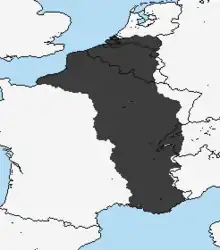Order-State of Burgundy
The Order-State of Burgundy (German: Ordensstaat Burgund), was a proposed state that the leadership of Nazi Germany, especially the Schutzstaffel (SS), hoped to establish in Occupied France and Occupied Belgium during World War II. The state was intended to reintroduce the political entity of Burgundy as a buffer against France. Its name was a historical reference to the State of the Teutonic Order.
Etymology
The name Burgundy itself is derived from the Burgundians, an East Germanic people who moved westwards beyond the Rhine during the late Roman period.[1] It is speculated that the name originates or is related to the island of Bornholm in Denmark.[2] The name Burgundy itself has historically denoted numerous political entities, having originated with the ancient Kingdom of the Burgundians, which after its conquest in 532 had formed a constituent part of the Frankish Empire.
Burgundy typically refers to a geographic area comprising the modern French region of Bourgogne-Franche-Comté, however it has historically also comprised lands as far south as Dauphiné and Provence.
Background

Nazi Germany sought and intended to eliminate France's threat potential as much as possible. The land zoned within the Zone interdite following the fall of France, as planned by the German Interior Ministry, along with additional territory west of this zone was intended to drive the French borders as far west as historically justifiable. The clear intentions of these plans were to reduce France permanently to a minor state and a German vassal that would be kept firmly in the state of dependence it found itself in following the 1940 armistice. Under the aforementioned arrangement, German colonial settlement was to be encouraged following the outright annexation of all lands intended for incorporation into Nazi Germany. It proposed the settlement of a million German peasants, and the French-speaking population was to be re-Germanized.[3] The plan considered those areas and Wallonia to be "in reality German" because of their historical German background and should therefore be re-integrated into the German Reich.[4][5]
There were several outspoken proponents for a Burgundian state rather than direct integration into the German Reich, the most outspoken of which being Reichsführer-SS Heinrich Himmler. According to Himmler, Burgundy, which he called "an ancient economic and cultural centre", had been "reduced to nothing more than a French appendage, known only for its wine production". The plan he came up with entailed the transformation of Burgundy into a model state, which would be nominally outside of the Greater Germanic Reich but ruled by a National Socialist government with additional Himmlerite characteristics. It was to have its own army, laws, and postal services. Its official language was to become German but would initially also be French.
Additionally, Burgundy was to have a chancellor with the additional title of Reichsverweser.[6] The position was intended to double as an undefined representative role to the German Reich. It was assumed and greenlit by Himmler himself that Léon Degrelle, leader of the Belgian fascists, would become the state's first chancellor.[7] Degrelle himself was also a proponent for the plan. His own objective in collaborating with the Germans during the war was to restore the Burgundian domain of Charles the Bold before his death in 1477 under his own rule.[8]
Whether the state was merely the personal dreams of Himmler or, as he claimed, held support from Adolf Hitler is inconclusive. Hitler's objective towards France following Operation Barbarossa was to eliminate it permanently as a possible strategic threat to Germany. Although initially the French campaign in Western Europe was carried out following Germany’s attack on Poland simply so that Germany's western flank could be secured,[9] Hitler also mentioned in 1942 that the former extent of the Kingdom of Burgundy, which France "had taken from Germany in her weakest moment", would also have to be annexed into Nazi Germany after the incorporation of the forbidden zone.[10]
Territorial planning

The plan assembled by Himmler envisioned the encompassment of Romandy, Picardy, Champagne, Franche-Comté, Bourgogne, Lorraine excluding Deutsch-Lothringen, Dutch Brabant, Dutch Limburg, and a sizeable portion of Dutch Zeeland, alongside Reichskommissariat Belgien-Nordfrankreich. It was also to have a connection to the Mediterranean Sea through Provence. The capital and administrative seat was tentatively proposed as either Dijon (Tischau), Gent, Lyon (Leiden), or Nancy (Nanzig).[11]
The western limit of Burgundy was never definitively settled. Some iterations of the plan supported a return to the late medieval borders of the Holy Roman Empire,[12] however some descriptions go as far as to include Upper Normandy with Rouen (Rudaburg) north of the River Seine.[13][14]
There were also proposals for an independent Breton state related to Burgundy.[10] Hitler himself mentioned his intentions for such a state on at least one occasion to his military leaders[15] but ultimately seemed to have taken little interest in the project.[10] Such a state would have provided the German Reich with an extra buffer against France along with access to the strategic port city of Brest.
See also
References
- Poupardin, René, Chisholm, Hugh, ed. (1911). . Encyclopædia Britannica (11th ed.). Cambridge University Press.
- Essai sur l'histoire du peuple burgonde, de Bornholm (Burgundarholm) vers la Bourgogne et les Bourguignons, 1965, by Rene Guichard, published by A. et J. Picard et Cie.
- Winkler, Heinrich August; Sager, Alexander (2007). Germany: The Long Road West. 1933-1990. Oxford University Press. p. 74. ISBN 0199265984.
- John Frank Williams (2005). Corporal Hitler and the Great War 1914-1918: the List Regiment. Frank Cass, p. 209
- Schöttler, Peter (2003). "'Eine Art „Generalplan West": Die Stuckart-Denkschrift vom 14. Juni 1940 und die Planungen für eine neue deutsch-französische Grenze im Zweiten Weltkrieg." (in ger). Sozial.Geschichte 18 (3): 83–131.
- NS-Zukunftspläne für Europa und die Welt. Retrieved 5 November 2010. (in German)
- NS-Zukunftspläne für Europa und die Welt. Retrieved 5 November 2010. (in German)
- Richard Landwehr, Jean-Louis Roba, Ray Merriam (2006). The Wallonien: The History of the 5th SS-Sturmbrigade and 28th SS Volunteer Panzergrenadier Division. Merriam Press, p. 5
- Norman Rich (1973). Hitler's War Aims: Ideology, the Nazi State, and the Course of Expansion. W. W. Norton & Company, New York. p. 146
- Norman Rich (1974). Hitler's War Aims: the Establishment of the New Order. W. W. Norton & Company Inc, New York. p. 239
- Books: If Hitler Had Won. Time Magazine, Monday, 24 March 1947.
- Schöttler, Peter (2003). "'Eine Art „Generalplan West": Die Stuckart-Denkschrift vom 14. Juni 1940 und die Planungen für eine neue deutsch-französische Grenze im Zweiten Weltkrieg." (in ger). Sozial.Geschichte 18 (3): 83–131.
- John Frank Williams (2005). Corporal Hitler and the Great War 1914-1918: the List Regiment. Frank Cass, p. 209
- Schöttler, Peter (2003). "'Eine Art „Generalplan West": Die Stuckart-Denkschrift vom 14. Juni 1940 und die Planungen für eine neue deutsch-französische Grenze im Zweiten Weltkrieg." (in ger). Sozial.Geschichte 18 (3): 83–131.
- Janusz Gumkowski and Kazimierz Leszczynski. Hitler's Plans for Eastern Europe. Selections from Poland under Nazi Occupation. Retrieved 5 November 2010